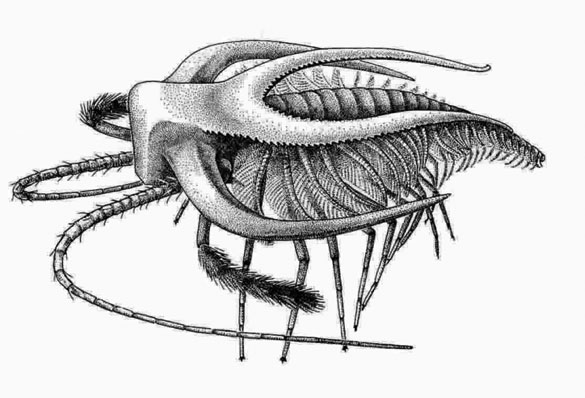 The first story about this iconic fossil is the trouble I went through to get the photograph above. Our specimen of Marrella splendens is preserved in the common Burgess Shale fashion as a thin dark film on a black piece of shale. A normal photograph would show just a black rock with a grayish smudge. To increase the contrast, I coated the fossil with mineral oil and used very bright lights to capture the image. I then tweaked the contrast further with Photoshop. Curiously, a black envelope appeared around the specimen that resembles the famous dark stain found with some Burgess Shale fossils. It may be remnants of body fluids.
The first story about this iconic fossil is the trouble I went through to get the photograph above. Our specimen of Marrella splendens is preserved in the common Burgess Shale fashion as a thin dark film on a black piece of shale. A normal photograph would show just a black rock with a grayish smudge. To increase the contrast, I coated the fossil with mineral oil and used very bright lights to capture the image. I then tweaked the contrast further with Photoshop. Curiously, a black envelope appeared around the specimen that resembles the famous dark stain found with some Burgess Shale fossils. It may be remnants of body fluids.

Before I go further, I must clarify the origins of this fossil from the Burgess Shale (Middle Cambrian) near Burgess Pass, British Columbia, Canada. I did NOT collect it. The Burgess Shale is a UNESCO World Heritage Site, so collecting there is restricted to a very small group of paleontologists who have gone through probably the most strict permitting system anywhere. I had a wonderful visit to the Burgess Shale with my friend Matthew James in 2009, and we followed all the rules. (The above is a photo of the Burgess Shale outcrop and its extraordinary setting.) Our Wooster specimen was in our teaching collection when I arrived. I suspect it was collected in the 1920s or 1930s. Marrella splendens is one of the most common Burgess Shale fossils, so no doubt there are many out there in older collections.
Marrella splendens is supposedly the first fossil Charles Doolittle Walcott discovered in the Burgess Shale in 1909. He called it a “lace crab”, and then later as a strange trilobite. Later work by Harry Whittington demonstrated that it was neither a crab nor a trilobite. It is likely a stem-group arthropod (near the base of arthropod phylogeny).
Marrella splendens was probably a bottom-dwelling deposit-feeder living on organic material in the seafloor sediment. There are thousands and thousands of specimens known in the Burgess Shale. They are preserved in many different angles, providing the first evidence that some sort of sedimentary mass movement was involved in the formation of this famous unit.
Walcott invented the name Marrella in honor of John Edward Marr (1857-1933). Marr was a paleontologist at Cambridge University in England. By the end of his career he was a Fellow of the Geological Society and the Royal Society, hence FGS and FRS follow his name.
Reference:
García-Bellido, D.C. and Collins, D.H. 2006. A new study of Marrella splendens (Arthropoda, Marrellomorpha) from the Middle Cambrian Burgess Shale, British Columbia, Canada. Canadian Journal of Earth Sciences 43: 721-742.




Walcott was known to trade specimens from the Burgess Shale for other specimens from other areas. The Burgess Shale specimens in the University of Kentucky collections were traded for local Ordovician critters.
That makes sense, Tim. We also would have had a lot of Ohio fossils to trade.